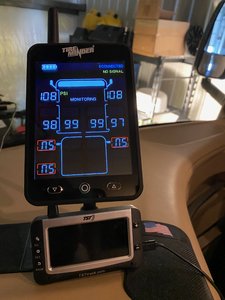Gizmo
RVF VIP
- Joined
- Nov 19, 2019
- Messages
- 484
- Location
- Kansas
- RV Year
- 2017
- RV Make
- Newmar
- RV Model
- Ventana LE
- RV Length
- 40
- TOW/TOAD
- 2020 Jeep Rubicon
We have the new Tire Minder system and to set the low and high pressure it uses 20% above and 15% below the preferred cold pressure setting. We set our rear tires to 95 PSI which gives us a high-pressure warning of 114 PSI and low pressure warning 89 PSI. Going a short 50-mile trip to get the oil changed the high-pressure warning went off on both inside rear tires with a pressure of 117 and the outside duals were running at 112. Both of our front tires were set at 105 cold and were just a couple of pounds below the high pressure warnings. The outside temp was about 70 degrees so in 100-degree weather in Texas this summer these settings are not going to work. According to Tire Minder with 95 PSI you should get less than 19 PSI increase in tire pressure.
What kind of pressure swings are you seen from say morning temp of 75 degrees and afternoon temp of 100-afternoon temps driving down an asphalt road?
Here is a pic of the new Tire Minder. The NS on the bottom is because I don't have my jeep hooked up.
What kind of pressure swings are you seen from say morning temp of 75 degrees and afternoon temp of 100-afternoon temps driving down an asphalt road?
Here is a pic of the new Tire Minder. The NS on the bottom is because I don't have my jeep hooked up.












